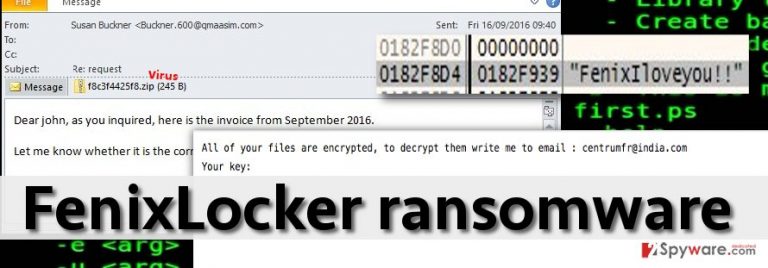FenixLocker ransomware / virus (Dec 2016 update) - Decryption Methods Included
FenixLocker virus Removal Guide
What is FenixLocker ransomware virus?
How dangerous is FenixLocker ransomware?
FenixLocker virus, which is also known as centrumfr@india.com ransomware, is yet another file-encrypting virus that spreads at alarming rates. It can silently enter the computer system by exploiting security vulnerabilities found in outdated software and similar methods. Once Fenix Locker gets inside the system, it activates itself and starts encrypting data with AES encryption[1]. This procedure transforms your useful files into broken records that cannot be opened or manipulated in any way. Besides, it also renames these files by adding .centrumfr@india.com file extension to them. It can take from one to a few hours to encrypt all files, and once finished, the virus crafts a ransom note and saves it on computer’s desktop. For some reason, the virus names the ransom note as CryptoLocker.txt or Help to decrypt.txt. It might be that it has been using such names just to scare its victims and mislead them into thinking that the virus they are dealing with is an infamous ransomware called Cryptolocker.[2] However, this malware can be called one of low quality ransomware threats[3] that seeks to earn the money for its creators, so there is no doubt that you must remove FenixLocker ransomware as soon as it shows up on your computer. The ransom note provided by this cyber threat claims:
All of your files are encrypted, to decrypt them write me to centrumfr@india.com
Your key: [Victim’s ID]

We already know how everything goes after victims send a letter to the provided email – crooks ask them to pay the money via Bitcoin payment system using Tor browser[4]. Please do not start searching for your wallet and bitcoins because you should not pay the ransom. Not only because you will support cyber criminals by funding their projects. Also, there is a free FenixLocker decrypter released by security experts some time ago. However, before using this tool we highly recommend you to remove this malware from the system. For instance, you can use FortectIntego to remove malicious files from your computer. We do not recommend opting for manual FenixLocker removal because this can be done only by advanced IT experts who know how to deal with such viruses and where do criminals tend to save malicious components. If you have no experience in dealing with malware, better use a professional automatic virus removal software instead.
How did this virus infect my computer?
FenixLocker ransomware spreads over the Internet concealed as a safe-looking file, in other words, it attempts to utilize Trojan horse technique. It can be added to malicious emails that criminals send to victim’s; it might also enter the system after installing a fake Java update[5]. Besides, now criminals are so advanced that they can infect even legitimate websites by delivering malware-laden ads; they also use exploit kits to take advantage of vulnerabilities in software that victim has installed on his/hers computer. The only way to prevent such malicious programs as FenixLocker from attacking the system is to establish a reliable protection software and avoid visiting suspicious domains, opening questionable emails or clicking on pushy ads. It is also a good idea to enable automatic updates to allow programs install their latest updates automatically – this way you will be sure that they are less vulnerable to computer threats and cannot be exploited that easily.
How do I remove FenixLocker virus from the infected computer?
If you have already been infected with this ransomware, you have to remove FenixLocker virus from the system without wasting your time. Please, do NOT postpone this and perform a full removal procedure on your computer immediately to prevent additional loss of your files. For that, we highly recommend using FortectIntego, SpyHunter 5Combo Cleaner and similar software which is considered powerful in ransomware removal. Besides, it will help you if you do not want to deal with the similar damage on your computer in the future. After you remove this cyber infection fully, you can use the free FenixLocker decryption tool and restore encrypted data. Make sure you don’t mix these steps and use the decrypter AFTER FenixLocker removal. Otherwise, you can find that your files are encrypted by this ransomware again.
Getting rid of FenixLocker virus. Follow these steps
Manual removal using Safe Mode
Important! →
Manual removal guide might be too complicated for regular computer users. It requires advanced IT knowledge to be performed correctly (if vital system files are removed or damaged, it might result in full Windows compromise), and it also might take hours to complete. Therefore, we highly advise using the automatic method provided above instead.
Step 1. Access Safe Mode with Networking
Manual malware removal should be best performed in the Safe Mode environment.
Windows 7 / Vista / XP
- Click Start > Shutdown > Restart > OK.
- When your computer becomes active, start pressing F8 button (if that does not work, try F2, F12, Del, etc. – it all depends on your motherboard model) multiple times until you see the Advanced Boot Options window.
- Select Safe Mode with Networking from the list.

Windows 10 / Windows 8
- Right-click on Start button and select Settings.

- Scroll down to pick Update & Security.

- On the left side of the window, pick Recovery.
- Now scroll down to find Advanced Startup section.
- Click Restart now.

- Select Troubleshoot.

- Go to Advanced options.

- Select Startup Settings.

- Press Restart.
- Now press 5 or click 5) Enable Safe Mode with Networking.

Step 2. Shut down suspicious processes
Windows Task Manager is a useful tool that shows all the processes running in the background. If malware is running a process, you need to shut it down:
- Press Ctrl + Shift + Esc on your keyboard to open Windows Task Manager.
- Click on More details.

- Scroll down to Background processes section, and look for anything suspicious.
- Right-click and select Open file location.

- Go back to the process, right-click and pick End Task.

- Delete the contents of the malicious folder.
Step 3. Check program Startup
- Press Ctrl + Shift + Esc on your keyboard to open Windows Task Manager.
- Go to Startup tab.
- Right-click on the suspicious program and pick Disable.

Step 4. Delete virus files
Malware-related files can be found in various places within your computer. Here are instructions that could help you find them:
- Type in Disk Cleanup in Windows search and press Enter.

- Select the drive you want to clean (C: is your main drive by default and is likely to be the one that has malicious files in).
- Scroll through the Files to delete list and select the following:
Temporary Internet Files
Downloads
Recycle Bin
Temporary files - Pick Clean up system files.

- You can also look for other malicious files hidden in the following folders (type these entries in Windows Search and press Enter):
%AppData%
%LocalAppData%
%ProgramData%
%WinDir%
After you are finished, reboot the PC in normal mode.
Remove FenixLocker using System Restore
-
Step 1: Reboot your computer to Safe Mode with Command Prompt
Windows 7 / Vista / XP- Click Start → Shutdown → Restart → OK.
- When your computer becomes active, start pressing F8 multiple times until you see the Advanced Boot Options window.
-
Select Command Prompt from the list

Windows 10 / Windows 8- Press the Power button at the Windows login screen. Now press and hold Shift, which is on your keyboard, and click Restart..
- Now select Troubleshoot → Advanced options → Startup Settings and finally press Restart.
-
Once your computer becomes active, select Enable Safe Mode with Command Prompt in Startup Settings window.

-
Step 2: Restore your system files and settings
-
Once the Command Prompt window shows up, enter cd restore and click Enter.

-
Now type rstrui.exe and press Enter again..

-
When a new window shows up, click Next and select your restore point that is prior the infiltration of FenixLocker. After doing that, click Next.


-
Now click Yes to start system restore.

-
Once the Command Prompt window shows up, enter cd restore and click Enter.
Bonus: Recover your data
Guide which is presented above is supposed to help you remove FenixLocker from your computer. To recover your encrypted files, we recommend using a detailed guide prepared by 2-spyware.com security experts.If your files are encrypted by FenixLocker, you can use several methods to restore them:
Relying on Data Recovery Pro to decrypt files encrypted by FenixLocker ransomware
If you are infected with FenixLocker ransomware, you can use Data Recovery Pro to recover your encrypted files. To use this program, follow the steps given below:
- Download Data Recovery Pro;
- Follow the steps of Data Recovery Setup and install the program on your computer;
- Launch it and scan your computer for files encrypted by FenixLocker ransomware;
- Restore them.
Using FenixLocker decrypter for unblocking encrypted files
To restore files encrypted by FenixLocker, remove the infection first using instructions provided above. Then download this FenixLocker decryption tool, install it and drag an example of encrypted file into it. Then the decrypted will sort out the decryption password needed to decrypt the rest of your data.
Finally, you should always think about the protection of crypto-ransomwares. In order to protect your computer from FenixLocker and other ransomwares, use a reputable anti-spyware, such as FortectIntego, SpyHunter 5Combo Cleaner or Malwarebytes
How to prevent from getting ransomware
Stream videos without limitations, no matter where you are
There are multiple parties that could find out almost anything about you by checking your online activity. While this is highly unlikely, advertisers and tech companies are constantly tracking you online. The first step to privacy should be a secure browser that focuses on tracker reduction to a minimum.
Even if you employ a secure browser, you will not be able to access websites that are restricted due to local government laws or other reasons. In other words, you may not be able to stream Disney+ or US-based Netflix in some countries. To bypass these restrictions, you can employ a powerful Private Internet Access VPN, which provides dedicated servers for torrenting and streaming, not slowing you down in the process.
Data backups are important – recover your lost files
Ransomware is one of the biggest threats to personal data. Once it is executed on a machine, it launches a sophisticated encryption algorithm that locks all your files, although it does not destroy them. The most common misconception is that anti-malware software can return files to their previous states. This is not true, however, and data remains locked after the malicious payload is deleted.
While regular data backups are the only secure method to recover your files after a ransomware attack, tools such as Data Recovery Pro can also be effective and restore at least some of your lost data.
- ^ Advanced Encryption Standard. Wikipedia, the free encyclopedia.
- ^ Jake Doe. What is Cryptolocker and how to remove this ransomware?. 2spyware. News and removal guides.
- ^ Karsten Hahn. The Rise of Low Quality Ransomware. G Data Security Blog.
- ^ What is Tor Browser?. Tor Browser Project.
- ^ Topher Kessler. Beware of fake Java updates. CNET Blog. Reviews, news, video.







